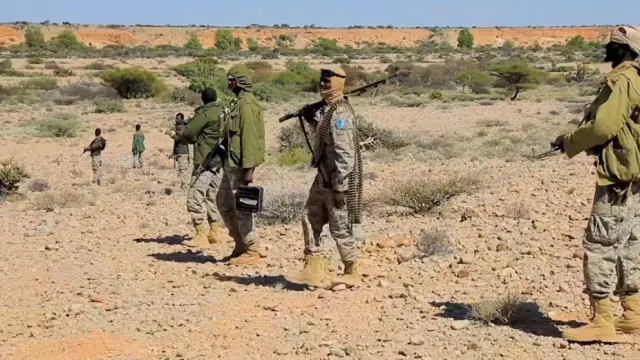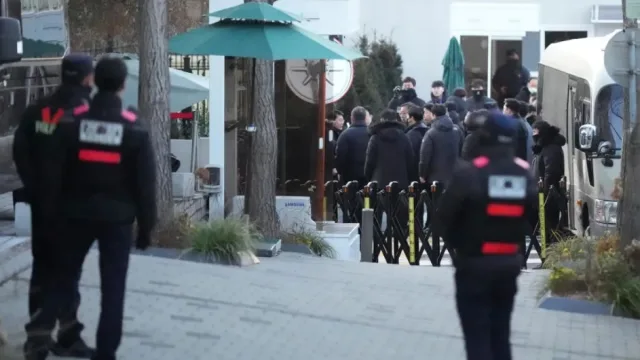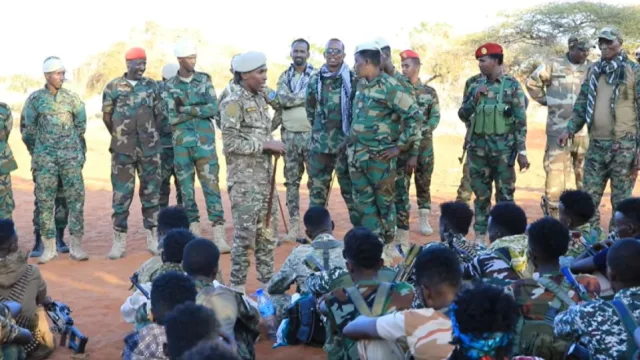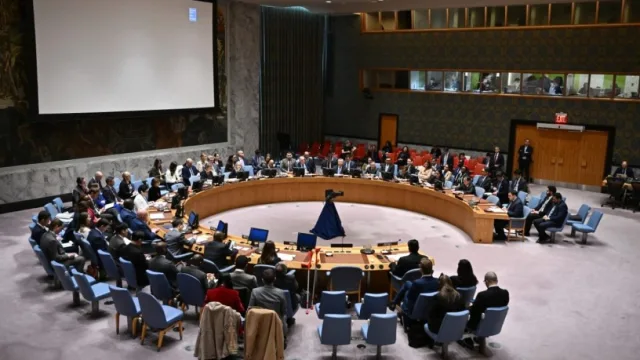Today (15 November), the Security Council is expected to vote on a draft resolution regarding a…

Today (15 November), the Security Council is expected to vote on a draft resolution regarding a request by the African Union (AU) to revise the operational timelines for the drawdown of the AU Transition Mission in Somalia (ATMIS). The draft text in blue also extends the authorisation for AU member states to deploy uniformed personnel in the country to carry out ATMIS’ mandated tasks until 30 June 2024. The draft text was authored by the UK, the penholder on Somalia.
The Security Council is also expected to vote on a UK-authored draft resolution renewing the 751 Al-Shabaab sanctions regime until 1 December. It seems that the penholder proposed a short technical rollover of the sanctions regime to allow time for further deliberations on its renewal. The short one-page draft text in blue renews the provisions contained in resolution 2662 of 17 November 2022, which last renewed the sanctions regime until 15 November. (The term “technical rollover” is commonly used by diplomats to describe a concise resolution extending a peace operation’s mandate without altering its core mandate or tasks, usually for a shorter period than is customary.)
Background on ATMIS
Pursuant to resolution 2687 of 27 June, which most recently renewed ATMIS’ authorisation, the AU was expected to withdraw 3,000 ATMIS personnel by 30 September as part of the second phase of the mission’s drawdown.
In a 19 September letter addressed to the Security Council, the Somali government requested a three-month technical pause in the drawdown of 3,000 ATMIS personnel. The letter reportedly said that, following the 26 August attack by Al-Shabaab in the Galguduud region, Somali forces suffered significant setbacks, and retreated from several towns that they had recently taken. It added that such incidents have exposed Somali forces’ vulnerabilities on the frontlines and have necessitated a thorough reorganisation to sustain the momentum in countering threats from Al-Shabaab.
In a 28 September letter, the Council agreed to continue the authorisation for the deployment of 3,000 uniformed personnel to ATMIS. The letter requested the UN to continue to support these troops until 31 October 2023 and the Secretary-General to pause the planned changes to the support provided by the UN Support Office in Somalia (UNSOS) to ATMIS and to Somali personnel, which were to start on 1 October 2023.
On 30 September, the AU Peace and Security Council (AUPSC) met to consider the Somali government’s request to extend the second phase of ATMIS’ operational timeline. In a communiqué adopted following the meeting, the AUPSC expressed support for the Somali government’s request and took note of financial shortfalls that could impede the operationalisation of such a technical pause. (For more information, see the brief on Somalia in our November 2023 Monthly Forecast.) On 10 October, Mozambique sent a letter to the Security Council communicating the AUPSC’s decision on the matter.
Negotiations on the Draft ATMIS Resolution
Tomorrow’s vote on ATMIS follows long and difficult negotiations. The UK circulated the initial draft of the resolution on 23 October and convened one round of negotiations on 25 October. Following bilateral consultations with some members, at least four revised drafts, and breaks of three silence procedures, the penholder placed a draft in text blue without a further silence procedure today (14 November).
It appears that the UK initially intended to put a draft resolution on ATMIS to a vote on or before 31 October. In light of continued disagreements and to allow further deliberations on the text, on 31 October, the Council sent a letter to the Secretary-General requesting that the UN continue its support to the 3,000 ATMIS personnel until 15 November.
In response to the AU’s request, the draft resolution in blue authorises the extension of the drawdown of 3,000 ATMIS personnel until 31 December. It also extends the authorisation for AU member states to deploy uniformed personnel in the country to carry out ATMIS’ mandated tasks until 30 June 2024. Therefore, taking into account the 4,000 ATMIS personnel that are expected to withdraw by the end of June 2024 as part of the third phase of ATMIS’ drawdown, the draft text in blue authorises ATMIS to maintain up to 14,626 uniformed personnel between 1 January and 30 June 2024.
Successful implementation of the security transition in Somalia hinges on the capacity of the Somali security forces to assume full security responsibility. There seems to be scepticism over Somalia’s readiness to do so, however, which has created concerns about the risk of leaving a security vacuum that could be exploited by Al-Shabaab. According to the 2 October final report of the Panel of Experts assisting the 751 Al-Shabaab Sanctions Committee, Al-Shabaab remains the most immediate threat to the peace, security, and stability of Somalia and its ability to carry out complex, asymmetrical attacks in Somalia remains undiminished. The report further noted that the prolonged fighting in Las Anod, a disputed area between Puntland and the self-proclaimed region of Somaliland, is having a destabilising effect on the security and stability of Somalia and may provide opportunities for Al-Shabaab and the Islamic State in Iraq and the Levant faction in Somalia (ISIL-Somalia) to take advantage of the situation.
Because of this issue, some Council members—including China and Russia—apparently opposed referencing December 2024 as the timeline for ATMIS’ final drawdown and exit, arguing that the Council must be guided by the changing security dynamics on the ground. Other members—including Albania, France, and Malta—seem to have insisted on the need to state this deadline, noting that it provides a clear objective for the mandate’s implementation. The reference to the December 2024 timeline was eventually retained in the draft resolution in blue.
The draft resolution in blue urges ATMIS and its troop- and police-contributing countries to work closely with the Somali government and federal member states to ensure that the third phase of ATMIS’ drawdown is gradual and conducted in line with Somalia’s strategic needs, including progress in force generation, as well as taking into account the situation in Somalia and the importance of maintaining security and stability.
Several reporting requirements are outlined in the draft resolution in blue. The draft text encourages the Somali government and international partners to consider the requirements for continued international support to Somalia’s security and greater Somali ownership following ATMIS’ exit. In this regard, it encourages the Somali government to present to the Council, by 31 March 2024, a proposal for security arrangements following ATMIS’ exit. The draft text in blue also requests the Somali government and the AU to conduct a joint technical assessment, by 31 March 2024, to evaluate the second phase of ATMIS’ drawdown and identify lessons with the aim of informing planning for the remaining drawdown phases.
The draft resolution in blue also requests the AU and the Somali government to provide an update, by 30 April 2024, on their preparations for the third phase of ATMIS’ drawdown, taking into account the lessons identified from the previous phases and setting out a clear plan and timeframe for the third phase.
A major point of disagreement during the negotiations related to one of the reporting requirements. The initial draft text recalled the Council’s intention, which was expressed in resolution 2687, to request the UN to build on the recent strategic review of the UN Assistance Mission in Somalia (UNSOM), that was issued on 26 September 2022, and commission an independent strategic review of UNSOS and to present a proposal for the future design of UN support to Somalia from 2025. The initial draft text further requested a proposal from the Secretary-General in this regard by 30 April 2024. It appears that the A3 members felt that the deadline indicated in the draft was too short and suggested a later deadline. At the same time, China and Russia apparently argued that in light of the rapidly changing security situation in Somalia, requesting UNSOS’ strategic review—without considering the implications of the extension of second phase of ATMIS drawdown as well as lessons from the third phase of the drawdown—would be unrealistic and hasty.
In an apparent compromise, the penholder proposed language expressing the Council’s intention to commission a strategic review of UNSOS through a letter from the Council president, after considering:
- The Somali government’s proposal for security arrangements following ATMIS’ exit, due by 31 March 2024; and
- The joint technical assessment by the Somali government and the AU evaluating the second phase of ATMIS drawdown, due by 31 March 2024.
The draft text in blue also addresses the financial and logistical difficulties facing ATMIS, which remain a matter of concern for the Council. The Secretary-General’s most recent report on UNSOM, dated 13 October, expressed deep concern about the current funding shortfall faced by ATMIS and urged donors to provide additional contributions. The draft resolution in blue encourages the traditional donors to ATMIS to continue supporting ATMIS until its planned exit by 31 December 2024, and calls for the enlargement and diversification of the donor base to provide the necessary funding for ATMIS and for the UNSOS-administered Somalia Trust Fund.
During the negotiations, the A3 members apparently proposed preambular language taking note of the shortfalls in financial resources that could impede the overall implementation of ATMIS’ mandate. It appears that the US sought to include language indicating performance and accountability as factors that could impede ATMIS’ mandate implementation. The A3 members, supported by China and Russia, apparently opposed this proposal, arguing that references to performance and accountability remain unclear if they are not supported by a dedicated assessment. The proposed language went through several revisions during the negotiations. The draft resolution in blue contains compromise language recalling that performance and accountability underpin the success of any mandate, noting that the availability of operational equipment and financial resources could, among other factors, affect the overall implementation of ATMIS’ mandate, and noting that ATMIS faces financial and equipment shortfalls.





